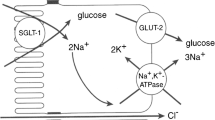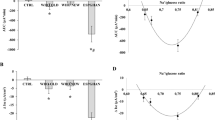Summary
Oral rehydration therapy with glucose-electrolyte solutions has been one of the major therapeutic advances of the century. This alarmingly simple intervention developed from a basic scientific observation in the laboratory, when it was shown that sodium and glucose transport in the small intestine are coupled and thus the presence of glucose in an electrolyte solution promotes absorption of both sodium ions and water. Even more important, sodium/glucose co-transport continues despite the secretory diarrhoea of cholera and enterotoxigenic E. coli and after intestinal damage due to rotavirus. Despite widespread use of the oral rehydration solutions (ORS) recommended by the World Health Organization (WHO), controversy continues about the optimal composition of these solutions. Discussion centres around the sodium and glucose concentrations, the osmolality and whether base (bicarbonate) or base-precursor (citrate) is necessary. Already there is a clear divide between the developing world, where the WHO solution (Na 90, glucose 111 and bicarbonate 30 mmol/L) is widely used, and the industrialised world, where solutions with lower sodium and until recently higher glucose concentrations have been favoured. Recently, attempts have been made to optimise ORS using animal and human model systems before submitting new candidate ORS to clinical trial. Results to date suggest that hypotonic ORS containing 50–60 mmol/L sodium and 90–100 mmol/L glucose produce maximal water absorption. The presence of base or base-precursor appears to offer little with regard to the promotion of sodium and water absorption and its role in combating acidosis remains controversial. Complex substrates such as rice powder and glucose polymers may eventually replace glucose in ORS, since their addition reduces ORS osmolality still further.
Similar content being viewed by others
References
Bhargava SK, Sachdev HPS, Das Gupta B, Daral TS, Singh HP, Mohan M. Oral rehydration of neonates and young infants with dehydrating diarrhea: comparison of low and standard sodium content in oral rehydration solutions. Journal of Pediatric Gastroenterology and Nutrition 3: 500–505, 1984
Chatterjee A, Mahalanabis D, Jalan KN, Maitra TK, Agarwal SK, et al. Oral rehydration in infantile diarrhoea. Controlled trial of low sodium glucose-electrolyte solution. Archives of Disease in Childhood 53: 284–289, 1978
Chatterjee HN. Control of vomiting in cholera and oral replacement of fluid. Lancet 2: 1063, 1953
Colle E, Ayoub E, Raile R. Hypertonic dehydration (hypernatremia): the role of feedings high in solutes. Pediatrics 22: 5–12, 1958
Crane RK. Hypothesis for mechanism of intestinal active transport of sugars. Federation Proceedings 21: 891–895, 1962
Csaky TZ, Thale M. Effect of ionic environment on intestinal sugar transport. Journal of Physiology 151: 59–65, 1960
Curran PF. Na, Cl and water transport by rat ileum in vitro. Journal of General Physiology 43: 1137–1148, 1960
Cutting WAM, Ellerbrock TV. Homemade oral solutions for diarrhoea. Lancet 1: 998, 1981
Darrow DC. The retention of electrolyte during recovery from severe dehydration due to diarrhea. Journal of Pediatrics 28: 515, 1946
Darrow DC, Pratt EL, Flett J, Gamble AH, Wiese HF. Disturbances of water and electrolytes in infantile diarrhea. Pediatrics 3: 129–156, 1949
Davidson GP, Gall DG, Petri M, Butler DG, Hamilton JR. Human rotavirus enteritis induced in conventional piglets. Intestinal structure and transport. Journal of Clinical Investigation 60: 1402–1409, 1977
Editorial. Water with sugar and salt. Lancet 2: 300, 1978
Elliott EJ, Watson AJ, Walker-Smith JA, Farthing MJG. Search for the ideal glucose-electrolyte oral rehydration solution (ORS) studies: in an animal model. Gastroenterology 90: 1405, 1986
Elliott EJ, Walker-Smith JA, Farthing MJG. The role of bicarbonate and base-precursors in the treatment of acute gastroenteritis. Archives of Disease in Childhood 62: 91–95, 1987a
Elliott EJ, Armitstead JCM, Walker-Smith JA, Farthing MJG. Experimental and clinical evidence against the need for base in oral rehydration solutions (ORS). Pediatric Research 22: 109, 1987b
Elliott EJ, Watson AJM, Walker-Smith JA, Farthing MJG. Effect of bicarbonate on efficacy of oral rehydration therapy: studies in an experimental model of secretory diarrhoea. Gut in press
Elliott EJ, Armitstead JCM, Farthing MJG, Walker-Smith JA. Oral rehydration therapy without bicarbonate. A double-blind controlled trial in children with acute gastroenteritis in the United Kingdom. Alimentary Pharmacology and Therapeutics 2: 253–262, 1988
Farthing MJG, Rolston DDK, Borodo MM, Kelly MJ. Efficacy of oral rehydration solutions (ORS) in an animal model of secretory diarrhoea. Gastroenterology 88(2): 1379, 1985
Finberg L. The role of oral electrolyte-glucose solutions in hydration for children: international and domestic aspects. Journal of Pediatrics 96: 51–54, 1980
Fisher RB. The absorption of water and of some small solute molecules from the isolated small intestine of the rat. Journal of Physiology (London) 130: 655–664, 1955
Fordtran JS, Rector FC, Carter NW. The mechanisms of sodium absorption in the human small intestine. Journal of Clinical Investigation 47: 884–900, 1968
Greenough WB. Super ORT. Journal of Diarrhoeal Disease Research 1: 74–75, 1983
Harrison HE. The treatment of diarrhoea in infancy. Pediatric Clinics of North America 1: 335–348, 1954
Hirschhorn N. The treatment of acute diarrhea in children. An historical and physiological perspective. American Journal of Clinical Nutrition 33: 637–663, 1980
Hirschhorn N, Kinzie JL, Sachar DB, Northrup RS, Taylor JO, et al. Decrease in net stool output in cholera during intestinal perfusion with glucose-containing solutions. New England Journal of Medicine 279: 176–181, 1968
Hunt JB, Elliott EJ, Fairclough PD, Farthing MJG. Effects of [Na] on water and Na absorption from hypotonie oral rehydration solutions (ORS). Clinical Science 74 (Suppl. 18): 2P, 1987a
Hunt JB, Watson AJM, Elliott EJ, Walker-Smith JA, Farthing MJG. Oral rehydration solutions (ORS): a comparison of efficacy in rat and human models. Gastroenterology 92: 1443, 1987b
Islam MR, Samadi AR, Ahmed SM, Bardhan PK, AH A. Oral rehydration therapy: efficacy of sodium citrate equals to sodium bicarbonate for correction of acidosis in diarrhoea. Gut 25: 900–904, 1984
Isolauri E. Evaluation of an oral rehydration solution with Na+ 60mmol/L in infants hospitalized for acute diarrhoea or treated as outpatients. Acta Paediatrica Scandinavica 74: 643–649, 1985
Kappy MS, Morrow G. Pediatrics for the clinician. A diagnostic approach to metabolic acidosis in children. Pediatrics 65: 351–356, 1980
Levine MM, Clements ML, Black RE, Hughes TP, Blum D, et al. A practical, reliable method for preparing simple sugar/salt oral rehydration solution. Journal of Tropical Medicine and Hygiene 84: 73–76, 1981
Lifshitz F, Wapnir RA. Oral hydration solutions: experimental optimization of water and sodium absorption. Journal of Pediatrics 106: 383–389, 1985
Mehta MN, Subramanian S. Comparison of rice water, rice electrolyte solution and glucose-electrolyte solution in the management of infantile diarrhoea. Lancet 1: 843–845, 1986
Molla MA, Rahman M, Sarker SA, Sach DA, Molla A. Stool electrolyte content and purging rates in diarrhoea caused by rotavirus, enterotoxigenic E. coli and V. cholera in children. Journal of Pediatrics 98: 835–838, 1981
Molla AM, Sarker SA, Hossain M, Molla A, Greenough WB. Ricepowder electrolyte solution as oral therapy in diarrhoea due to Vibrio cholerae and Escherichia coli. Lancet 1: 1317–1319, 1982
Nalin DR, Cash RA, Islam R, Molla M, Phillips RA. Oral maintenance therapy for cholera in adults. Lancet 2: 370–373, 1968
Nalin DR, Cash RA, Rahman M, Yunus MD. Effect of glycine and glucose on sodium and water absorption in patients with cholera. Gut 11: 768–772, 1970
Nalin DR, Levine MM, Mata LJ, De Cespedes C, Vargas W, et al. Oral rehydration and maintenance of children with rotavirus and bacterial diarrhoeas. Bulletin of the World Health Organization 57: 453–459, 1979
Nalin DR, Harland E, Ramlal A, Swaby D, McDonald J, et al. Comparison of low and high sodium and potassium content in oral rehydration solutions. Journal of Pediatrics 97: 848–853, 1980
Patra FC, Mahalanabis D, Jalan KN, Sen A, Banerjee P. Is oral rice electrolyte solution superior to glucose electrolyte solution in infantile diarrhoea? Archives of Disease in Childhood 57: 910–912, 1982a
Patra FC, Mahalanabis D, Jalan KN, Sen A, Banerjee P. Can acetate replace bicarbonate in oral rehydration solution for infantile diarrhoea? Archives of Disease in Childhood 57: 625–637, 1982b
Patra FC, Mahalanabis D, Jalan KN. Stimulation of sodium and water absorption by sucrose in the rat small intestine. Acta Paediatrica Scandinavica 71: 103–107, 1982c
Patra FC, Mahalanabis D, Jalan KN, Sen A, Banerjee P. In search of a super solution: controlled trial of glycine-glucose oral rehydration solution in infantile diarrhoea. Acta Paediatrica Scandinavica 73: 18–21, 1984
Phillips RA. Water and electrolyte losses in cholera. Federation Proceedings 23: 705–712, 1964
Pierce NF, Banwell JG, Mitra RC, Caranasos GJ, Keimowitz RJ, et al. Effect of intragastric glucose-electrolyte infusion upon water and electrolyte balance in Asiatic cholera. Gastroenterology 55: 333–343, 1968
Pradera FS, Fernandez E, Colderin O. Coconut water: a clinical and experimental study. American Journal of Diseases in Childhood 64: 977, 1942
Rabbani GH, Gilman RH, Spira WM. Intestinal fluid loss in shigella dysentery: role of oral rehydration therapy. Lancet 1: 654, 1983
Raghu MB, Deshpande AP, Chintu C. Oral rehydration for diarrhoeal diseases in children. Transactions of the Royal Society of Tropical Medicine and Hygiene 75: 552–555, 1981
Riklis E, Quastel JH. Effects of cations on sugar absorption by isolated surviving guinea pig intestine. Canadian Journal of Biochemistry and Physiology 36: 347–363, 1958
Rolston DDK, Kelly MJ, Borodo MM, Farthing MJG, Clark ML, Dawson AM. Acetate and bicarbonate enhance cholera toxin induced secretion in the rat proximal small intestine. Gut 25: 1163, 1984
Rolston DDK, Moriarty KJ, Farthing MJG, Kelly MJ, Clark ML, Dawson AM. Acetate and citrate stimulate water and sodium absorption in the human jejunum. Digestion 34: 101–104, 1986
Rolston DDK, Borodo MM, Kelly MJ, Dawson AM, Farthing MJG. Efficacy of oral rehydration solutions in a rat model of secretory diarrhoea. Journal of Pediatric Gastroenterology and Nutrition 6: 624–630, 1987
Sack DA, Chowdhury AMAK, Eusof A, Ali MA, Merson MH, et al. Oral rehydration of rotavirus diarrhoea: a double blind comparison of sucrose with glucose electrolyte solution. Lancet 2: 280–283, 1978
Sandhu BK, Jones BJM, Brook CGD, Silk DBA. Oral rehydration in acute infantile diarrhoea with a glucose-polymer electrolyte solution. Archives of Disease in Childhood 57: 152–154, 1982
Santosham M, Daum RS, Dillman L, Rodriguez JL, Luque S, et al. A controlled study of well-nourished children hospitalized in the United States and Panama. New England Journal of Medicine 306: 1070–1076, 1982
Saunders DR, Sillery JK. Absorption of carbohydrate-electrolyte solutions in rat duodenojejunum. Implications for the composition of oral electrolyte solutions in man. Digestive Diseases and Science 30: 154–160, 1985
Schedl HP, Clifton JA. Solute and water absorption by human small intestine. Nature 199: 1264–1267, 1963
Schmitt MG, Soergel KH, Wood CM. Absorption of short chain fatty acids from the human jejunum. Gastroenterology 70: 211–215, 1976
Schultz SG, Zalusky R. Ion transport in isolated rat ileum II. The interaction between active sodium and active sugar transport. Journal of General Physiology 47: 1043–1059, 1964
Sladen GE, Dawson AM. Interrelationships between the absorptions of glucose, sodium and water by the normal human jejunum. Clinical Science 36: 119–132, 1969
Turnberg LA, Fordtran JS, Carter NW, Rector FC. Mechanism of bicarbonate absorption and its relationship to sodium transport in the human jejunum. Journal of Clinical Investigation 49: 548–556, 1970
Vesikari T, Isolauri E. Glycine supplemented oral rehydration solutions for diarrhoea. Archives of Disease in Childhood 61: 372–376, 1986
Wapnir RA, Lifshitz F. Osmolality and solute concentration: their relationship with oral hydration solution effectiveness: an experimental assessment. Pediatric Research 19: 894–898, 1985
Wong HB. Rice water in the treatment of infantile gastroenteritis in Singapore. Journal of the Singapore Paediatric Society 23: 3–4, 1981
World Health Organization. A manual for the treatment of acute diarrhoea. WHO/CDD/SER/80.2 Rev 1/WHO, Geneva, Switzerland, 1984
Author information
Authors and Affiliations
Rights and permissions
About this article
Cite this article
Farthing, M.J.G. History and Rationale of Oral Rehydration and Recent Developments in Formulating an Optimal Solution. Drugs 36 (Suppl 4), 80–90 (1988). https://doi.org/10.2165/00003495-198800364-00011
Published:
Issue Date:
DOI: https://doi.org/10.2165/00003495-198800364-00011




